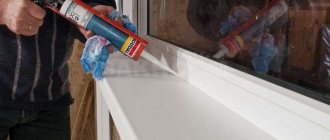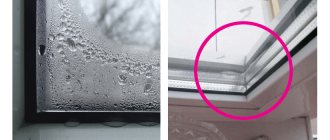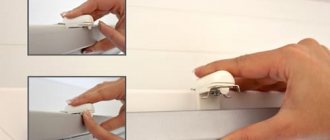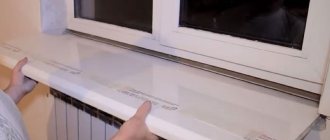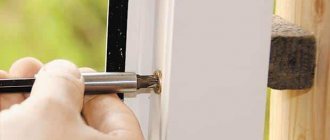Gallery of potential problems with installed windows
Example 1
Description of the problem:
The window opening was destroyed during the dismantling of the old window unit and was not restored during the installation of the new window unit. Polyurethane foam is not protected from natural factors (UV radiation, water, mechanical stress, etc.), which leads to its destruction. The assembly seam quickly fails; durability equal to 20 conventional years of operation, required according to GOST 30971, is not ensured. The installation does not meet the requirements of GOST 30971 and GOST R 52749. The aesthetics of the work performed also leaves much to be desired.
Solution to the problem:
Remove the destroyed foam and replace it with fresh one, which may require opening the internal slopes, restoring the damaged sections of the opening, organizing protection of the foam from adverse effects taking into account the requirements of GOST 30971 and GOST R 52749, restoring the internal slopes if opening them is required.
Example 2
Description of the problem:
The opening was not prepared for installation; the main surfaces were not leveled. Excess polyurethane foam on the street side was unevenly cut or picked off, after which acrylate sealant was uncontrollably and chaotically applied to the foam. The sealant in this form is not able to perform its functions. The foam is not sufficiently reliably covered with sealant, which makes it unprotected from the effects of natural factors (UV radiation, water, mechanical stress, etc.), thus, the required durability of the assembly seam (20 conventional years) is not ensured. The aesthetics of the work is not ensured. Installation does not meet the requirements of GOST 30971 and GOST R 52749.
Solution to the problem:
Remove the sealant, clean all surfaces of it, remove the destroyed polyurethane foam and replace it with fresh one; if destruction has already occurred, install a special cover or corner on the outside that covers and protects the foam from the effects of natural factors. The cover must be installed in such a way that the requirements of GOST 30971 and GOST R 52749 are met.
Example 3
Description of the problem:
On the outside of the installation seam, a vapor-tight rope made of foamed polyethylene is used, which does not provide the required waterproofing of the installation seam. Also, this tourniquet is not resistant to external influences; destruction of the tourniquet is clearly visible. Uneven surfaces of the opening do not allow for a tight connection of the harness to them, thus waterproofing is not provided. The rate of destruction of the harness indicates that the durability of the assembly seam, equal to 20 conventional years of operation, according to the requirements of GOST 30971, is not ensured. Thus, the installation does not comply with the requirements of GOST 30971 and GOST R 52749.
Example 4
Description of the problem:
Mold appeared on the plastered slopes, which indicates that the surface temperature of the slopes was low, freezing actually occurred in the area of the installation seam, condensation began to form on the surfaces of the slopes, the plaster became significantly moistened, and favorable conditions for the appearance of mold arose. Most likely, the foam insulation in the installation seam has collected a large amount of moisture and stopped working effectively.
Solution to the problem:
Remove the part of the slope plaster affected by mold (up to the brick), and inspect the exposed assembly seam. Remove wet mounting foam, which is most likely also affected by mold. If there is no waterproofing, vapor-permeable layer on the outside of the installation seam, completely dismantle the window unit, reinstall it in accordance with the requirements of GOST 30971 and GOST R 52749, and also take measures to insulate the slopes using expanded polystyrene sheets and refinish the slopes.
Example 5
Description of the problem:
- Heavy condensation on the surfaces of window units. The problem is most often associated with the following factors:
- The glass unit in the window unit does not provide the necessary thermal protection (single-chamber, too thin).
- The window sill board blocks a normally operating heating radiator, which creates an obstacle to the circulation of warm air across the surfaces of the window unit.
- The heating radiator is missing or does not work efficiently, which does not ensure normal circulation of warm air across the surfaces of the window unit.
- The humidity in the room is too high or the temperature is too low, which aggravates the formation of condensation on the surfaces of window units.
Solution to the problem:
Replace the double-glazed window with one that provides the required heat-insulating properties, replace the window sill with a narrower one that does not block the heating radiator, or organize air channels that supply warm air from the heating radiator directly to the window unit, increase the temperature of the radiator or replace the radiator itself with a more efficient one, ventilate the room more often.
How to cover construction foam on windows: how to achieve optimal results
Photo from website: Obustroeno.com
In view of all of the above, since everyone wants to maximize the service life of window units, the question of how to hide the mounting foam on PVC windows so that neither moisture, nor the sun's rays, nor frost or heat can damage it becomes very relevant. Moreover, in fact, there may be several answers, and everyone is free to choose exactly the option that he likes most, and also seems simpler and more accessible to implement. The only thing that is undeniable is that all this will have to be done quickly, so as not to change the entire structure later, which will cost much more.
Before you start figuring out how to close the foam around a window from the street, you should definitely think about using a special PSUL tape, more details about the properties and qualities of which can be read on our website.
- The most popular method of sealing an assembly joint with protruding foam is ordinary cement-sand plaster. Such a seal will be cheap, but it cannot be called the best, since freezing and leakage are possible, and therefore condensation may occur, which in turn can cause fungus or black mold to appear on the walls.
- There is also the option of sealing polyurethane foam using special sealing compounds, for example, based on polyurethane. But then the surfaces will have to be finished with something additional.
- In-demand and relevant means are the finishing of slopes, and, consequently, the sealing of foam, covering with plastic, sandwich panels, plasterboard or even wood.
- A good way to cover the mounting foam on a window is also a special plaster mixture, which is designed for temperatures well below zero, if we are talking about the external wall of a building.
- Acrylate paint or also liquid plastic is another fairly popular and not too expensive product that will help you cope with the task.
Photo from the site: StenaMaster.ru
Indeed, there are simply a colossal number of methods and methods for sealing an assembly seam, that is, in fact, protecting the foam from external influences, and one of them can be called the most commonplace window putty. The main thing here is not to make a mistake, and to choose the right material, depending on the final goals, as well as the operating conditions of the structure. On the outside of the window opening, you should use only frost-resistant mixtures that are not afraid of moisture and ultraviolet radiation, always remember about the water barrier and vapor barrier, and from the inside, always remember about temperature changes.
It is clear that if you have absolutely no idea how and with what to cover the foam after installing plastic windows, it may be better to entrust this task to real professionals. They are the ones who can give a guarantee for the work done. If the foam crumbles or loses its properties, it is not at all excluded that even the PVC profile of the frame may become deformed, and then the entire window unit will have to be replaced, and this is a colossal expense. So if you are not sure, then it is better not to do the work yourself, although it is not particularly difficult.
installation of the upper plastic slope
Work on installing plastic slopes should begin from the top of the window. This order of work is due to a number of reasons. Firstly, the side (vertical plastic slopes) will serve as additional support for the top (horizontal) panel. Secondly, you won’t have to step on the newly installed plastic window sill.
Let's start taking measurements. It's worth being more careful here. The fact is that the length of the slope near the window is less than the length of the side facing the apartment (from the side of the apartment the opening is wider than the same opening near the window). We measured the panel and cut it. Before you begin installation, it would be a good idea to try on the cut piece. Tried it on. Fits. Let's start the installation.
With a given slope width (430 mm when unfolded), foaming is carried out in several stages. The fact is that when the polyurethane foam hardens, it expands, and when applying a continuous foam layer between the wall and the PVC panel, there is a risk of deformation of the panel.
The first step is to apply a continuous layer of polyurethane foam at the junction of the plastic slope and the window. Temporarily secure the plastic panel to the wallpaper with masking tape (the wallpaper should not be paper). After some time, depending on the amount of foam applied in the first layer, we tear off the paper tape, carefully bend the panel, and apply the next layer of foam. We repeat the operation with molar tape. The number of layers of foam is individual in each case.
How to get a quality seam
The quality of the foam seam is influenced by several factors:
- foam quality;
- shaking the container before use;
- canister temperature;
- squeezed out amount of foam;
- level of humidity in the air and window opening.
Failure to comply with one or more conditions can ruin the entire work. This becomes especially noticeable after the first frost. It is important that the foam adheres well to the surface, and that the opening is completely filled, without through holes.
How does polyurethane foam work? The cylinders contain liquid foam and a mixture of gases. When the container is opened, the gas pushes the base out. The foam is filled with bubbles from the air. And under the influence of moisture in the atmosphere, it begins to expand and harden.
What is the best polyurethane foam for PVC windows?
The Construction and Repair portal will not describe the properties of polyurethane foam in this review. Although this material is modern and new, it quickly conquered the market. Everyone has already heard, seen and felt its excellent insulating properties. Let's look at how it differs and what types there are.
Types of polyurethane foam
Professional/household
These types of foam differ not in composition, but in the type of container. Professional ones have a special arrangement of cylinders that are designed for the pistol.
A mounting gun is a special device with a long narrow tube that delivers foam in measured doses. This tool saves material consumption; the long tube reaches hard-to-reach places. Easy to use, lightweight, allows you to work with one hand.
It is natural to assume that since the instrument is professional, it is not cheap. And if a lot of work is not expected, then there is a semi-professional option - a plastic adapter for the cylinder.
This is also a narrow, small plastic tube with a dosage valve that fits onto a foam bottle. This option is used only in the upside down position, unlike the pistol, which can be used in any way.
the best polyurethane foam for PVC windows based on the volume of work and remember that you won’t be able to use a bottle of foam for a gun yourself without a tool.
Summer/winter
Based on the temperature at which work can be carried out, foam is divided into summer and winter. The summer one can be used at temperatures of +5 °C–+35°C, the winter one at -20 °C.
These parameters affect the hardening of the foam only during work with the foam. Both options, after polymerization, perfectly maintain temperatures from -50°C to +90°C. There is an all-season foam option, but it is rare.
Flammable/self-extinguishing/fireproof
Also, types of foam are divided according to fire safety. Combustible is marked B3, self-extinguishing B2, and the best safety option is B1 fireproof.
Single/multi-component
The best polyurethane foam for PVC windows is also selected based on its component composition. The most common one-component foam. It is easier to use and more convenient. This type of foam is an aerosol and its composition is polyurethane.
When sprayed, it reacts with air and turns into foam, which can fill any space. Since this occurs under pressure, the material, expanding sharply, enters any cracks and seals due to the porous-spongy structure. Polyurethane with foaming agents hardens due to the moisture content in the air. Therefore, in winter, when the climate is drier, special foam is needed. Hardening time – 24 hours.
Tip: to speed up hardening, the surface to be treated with foam can be wetted.
How to choose - useful tips
- Check the fullness of the cylinder. If foam is not added to the container, then the pressure is insufficient and all of it will not come out. Therefore, underfilling + underused part significantly increases the cost of the material. We check this: a 750 ml foam container. – weighs from 850 to 920 grams.
- Check the expiration date. It is better not to take expired foam or the expiration date of which is coming to an end.
- Check the secondary extension. Any foam has two expansion phases. Primary, upon application. And the secondary expansion phase, when the material expands during drying and several days. This indicator for a good foam should be no more than 15-20%.
Classification
Before purchasing, the consumer needs to know how to choose foam for installing plastic windows.
If you pay attention to the design of the cylinder and the properties of the active substance, the sealant is divided into professional and household. At first glance, the difference between them may seem insignificant, but there is one.
The design of any cylinder includes a spray mechanism (adapter tube). Also, when working with polymer, a special gun is used.
It allows you to deliver material in portions to all recesses, crevices, and cracks. In this way, the master controls the amount of sealant supplied and reduces its consumption.
Professional
The first option is used in places where there is a need to fill large spaces. This foam for installation of plastic windows is packaged in cylinders with an internal partition. It separates the components. They mix only at the outlet of the sprayer.
This cylinder cannot be used all at once. When reusing, just shake the packaging and blow out the outlet nozzle.
Domestic
A cylinder of mounting polymer for domestic use does not differ in appearance from a professional one. The difference lies in the internal design of the packaging. There are no partitions inside, all substances are mixed.
This makes it impossible to reuse if you leave the already started cylinder for later uses.
Such consumables are cheaper than professional ones, but are not inferior to them in quality and characteristics.
Seasonal
The manufacturer produces several types of polymer sealant.
- Summer. It is used in the warm season, when the temperature is from +5 to +35°C.
- Winter. This foam for installing plastic windows is adapted for use in the cold autumn and winter periods. The minimum permissible temperature threshold is -18°C. This versatility is explained by the presence of special impurities.
- All-season. Its composition combines the improved qualities of previous options. It has a high coefficient of expansion and also foams quickly at low temperatures.
The choice of sealant must be approached very carefully. The quality of installation and operation of window and other structures depend on this.
Foam use
The main type of installation of metal-plastic windows is replacing old with new. Workers remove the old window frame and put a PVC frame in its place. It is not always possible to accurately take into account the dimensions and all the digital indicators of the window opening.
The opening is covered with a special sealing tape. This is done before starting installation work. The tape is compressed tightly so that the window does not become crooked because of it. This material is impregnated with a special composition that increases its service life.
If you are installing windows in autumn, winter or early spring, the tape must first be warmed up. To do this, use a hair dryer. The window is also installed on the warm tape using spacer wedges.
The side parts of the PVC are reinforced with vapor barrier tape. Gaps when installing windows are filled with polyurethane foam. This is a very important stage, because high-quality foam and proper installation ensure high-quality window performance.
It is important that the polyurethane foam does not come out.
To do this, use waterproof tape. It also protects the foam from moisture and sun exposure. Excess foam is removed after hardening. Next, the gap on the inside of the window (that is, on the room side) is finished with a protective vapor barrier film.
Frame installation
Installation of metal-plastic windows is prescribed in the state standard. All stages of work are indicated there. It begins with drilling holes in which the anchors are attached. All side openings are covered with waterproofing tape.
It is worth paying attention to the gap between the wall and the frame. It should not exceed 12 cm. The width of the gap is approximately 1-4 cm, and the gap itself is up to 2 cm.
The next stage of work is the insertion of three horizontal frame elements. Anchors are used for their fastening. After all installation procedures, the wedges and gaskets are removed. Next, you need to make recesses in the support blocks, each no more than 1.5 cm. After this, install the ebb, which is attached with screws to the frame or dowels to the wall.
Eliminating the installation gap when installing a window sill
The next stage of installation of PVC windows is the installation of a window sill. Next, a double-glazed window is inserted and the sashes are hung. When installing windows, foam is poured into the gaps. Its calculation is equal to 2/3 of the gap depth. When all installation work is completed, the structure is configured and adjusted.
The most common mistake during installation is applying plaster. It is used on slopes, both external and internal. According to GOST, these areas must be coated with a composition that does not conduct steam and moisture.
This is not the only mistake. Typically, all installation defects are associated with the following factors:
- The desire of buyers to save on consumables.
- Low qualifications of workers.
As for the first point, this is, for example, as mentioned above, the use of cheaper plaster, and not a specially expensive mixture when processing slopes.
Even minor mistakes or deliberate deviation from GOST points can lead to serious problems during the subsequent operation of the window.
GOST for the installation of plastic windows was introduced in 2003. It is there that all stages of installation and the dimensions of possible gaps are spelled out. All points of the standard must be fulfilled without deviations.
Important contract requirements
Companies enter into an agreement with each buyer who has purchased and ordered the installation of PVC windows. This document must necessarily contain information about installation, its stages, and requirements for it. All this must comply with state standards. And in accordance with SNiP, companies that sell and install plastic windows must have their own instructions for their employees.
The buyer must remember the acceptance and delivery certificates of both the window itself and the installation work. Of course, not all consumers are familiar with state standards. Our advice is to familiarize yourself with them so as not to rely only on the conscientiousness of the workers.
For example, one of the requirements is checking the temperature level. If this is not done, condensation will constantly accumulate in the area of the seams, and the slopes will not protect against moisture.
Profiles ONLY of the highest class “A”
Having decided to replace the windows with plastic ones, it is important to choose the right design. It is very important that it be a class “A” profile
The features of this profile are difficult to overestimate:
- the thickness of the outer walls is about 2.8 mm, the inner walls are 2.5 mm;
- high resistance to heat transfer;
- the ability to muffle sounds whose volume reaches 36 dB;
- withstand strong wind loads, up to 1000 kg s/m2 (the indicator is equal to a wind speed of 40 m/s0;
- resistance to weather conditions, for 40 years of operation. wall thickness can be reduced to 0.7 mm;
- complete protection from cold, reducing space heating costs by up to 25%;
- a profile whose outer wall is 3 mm thick can be used for 50 years (a similar load on a thin-walled profile will have much lower service life);
- welded connections of class “A” have a strength that is 20% greater than that of profiles belonging to class “B”.
Before you begin repairing or replacing a window system, you need to pay attention to a number of important points:
- It is better to choose profiles with 3 or 4 chambers; they will affect the level of heat and sound insulation of the room.
- You can choose a design that suits the interior and exterior of the building, it can have a straight or rounded design.
- You should not save on purchasing high-quality fittings; they will be responsible for comfort and convenience during opening. closing the doors.
- It is important to remember the components that give the entire structure a finished look. We are talking about the installation of ebbs, window sills, slopes, canopies, and other components.
- Before installing a new system, you need to pay enough attention to dismantling the old one. What form the opening will be in. has a great influence on the quality of subsequent installation work.
How to seal and why do it?
Have you found a gap between the wall and the window? Urgently contact the Teplo Doma company for help. It will only get worse: draft, condensation, mold, slope destruction.
What material is required to successfully seal the seams of plastic windows? Today, for these purposes, as a rule, one-component polyurethane, or in other words, polyurethane foam, is used. This method has a lot of undeniable advantages:
- The foam evenly fills the gap and does not let air through.
- Capable of carrying quite heavy loads.
- Has excellent thermal insulation characteristics.
- It's inexpensive.
- She's easy to work with.
There are many building materials, but none can compete with polyurethane foam in this matter.
Of course, working with foam is convenient and profitable, but there are also negative aspects. Illiterate use of this material can lead to extremely unpleasant moments. For example, you knew that polyurethane should never be left in the sun, because it is destroyed by ultraviolet rays. You probably heard it. But some developers probably have no idea that polyurethane foam needs to be protected. This is evidenced by open seams between plastic windows and openings on the facades of new buildings.
After the polyurethane foam has dried, you need to trim off the excess, and then cover it with putty and paint. Let's not forget that one-component polyurethane absorbs water well, so it definitely needs a protective layer. There may also be a sealant for exterior use. Only in this way can high-quality external sealing of the window be carried out.
It is worth noting that dried foam can change in volume under the influence of temperatures. One-component polyurethane can expand by 5-10% in hot weather, and vice versa shrink in cold weather. As a result, the metal-plastic structure will “walk” along the opening. This must be taken into account during installation. You still have a question: where did the cracks come from? Incorrect installation is to blame.
If you encounter such a problem, contact the Teplo Doma specialists right now. Our craftsmen will be happy to repair your windows and eliminate the draft.
To eliminate the problem, it is necessary to clean out the old foam, then a new sealing of the installation seam is required, and then the one-component polyurethane should be protected from the sun and precipitation.
How to solve the problem when it blows from plastic windows
During the onset of cold weather, you want to keep warm in every possible way.
It is impossible to solve this problem when it is blowing from plastic windows. No matter how tight and reliable manufacturers promise, in practice these conditions are not always met. What to do? This problem is caused by many factors, by identifying which it is possible to minimize the heat loss of plastic structures. Initially, you need to decide why cold air currents form near the window. Shifting air boundaries can occur due to temperature differences - this is only the only investigative factor. A wax candle will help determine this reason: it is set on fire and carried around the perimeter of the doors, the flame of the candle will show where the draft is coming through.
The junction of the main frame with the slopes is another vulnerable point. It can make itself felt if the windows are installed incorrectly. As a rule, you have to deal with installation defects yourself, since the warranty period expires quickly.
Prevention of plastic windows
The effective service life of window structures also depends on how you follow the operating rules. And for this there are basic recommendations:
- You need to order the installation and the windows themselves from the same company, so as not to find yourself “between two fires”;
- you have the opportunity to control the installation process, from careful treatment with polyurethane foam to the evenness of the window structure;
- do not be tempted by cheap materials that have questionable durability and reliability;
- Windows need to be provided with proper care at all times: wash them from dirt, otherwise the seal gets clogged and loses its properties; close carefully and without sudden movements, lubricate the mechanisms;
- when changing accessories, choose exclusively high quality;
- Entrust all repair work to specialists, be it complex (related to disassembly) or simple (reinstallation of seals, fittings).
Drafts from windows: reasons
This problem is usually caused by:
- defects that come from factory conditions;
- use of plastic or low quality fittings;
- installation errors.
That is, the performance of the window depends on the correctly selected fittings and not only:
- poor quality seal;
- loose fit of the valves;
- violation of the integrity of the plastic;
- insulation of slopes is not provided;
- the appearance of gaps in the window sill area.
Often, a draft over the entire window area can occur if the sashes do not fit tightly to the frame. With such a problem, the existing window system needs to be adjusted - the sash pins are fixed in the maximum position in the clockwise direction. You can do this yourself using a screwdriver or pliers. Some window designs have an automatic adjustment system so that the user can easily change the summer mode to another.
The appearance of drafts can be eliminated in another way:
- if it leaks from under the window sill, then the reason is its leakage (the space needs to be filled not only with polyurethane foam, but also plastered);
- if blowing is observed from the slopes, then the problem arose due to loosening of the installation seam - to eliminate it, the slopes should be dismantled and foamed all over again around the perimeter;
- a draft from the joint of the frame indicates that the entire structure is defective - in this case it is worth treating the cracks from the outside using a sealant that is indifferent to cold and frost;
- if it comes through from the hinge side, then most likely you should pay attention to the unfilled mounting holes;
- A draft may also occur in places where there is a seal that dries out over time - this can be easily solved by replacing the seal, which is selected based on the window profile;
- at the points where the frame connects to the window sill, draft problems may also arise, which need to be resolved in a timely manner (the mounting foam is puttied in advance so that the structure does not settle);
- blows between the frame and the adjacent wall, then this is a consequence of saving materials (it is necessary to better process the seams or reinstall the window).
Before solving the problem of eliminating blowing, it is necessary to accurately identify the source: window sill, seals, slopes, etc. The system also needs to be adjusted so that cold air does not come from the street. It is also worth considering that within 5-10 years the mounting foam becomes brittle, as a result of which blowing from the slopes cannot be avoided (the window will need to be foamed again).
Plastic window structures in themselves do not cause problems if they are correctly selected and installed, so all necessary measures should be taken even before their installation. A high-quality window design, including a strong and reliable PVC profile, durable fittings and an elastic seal, will help put troubles into the background. In the market segment, it is worth choosing manufacturers who have proven themselves well.
It is worth monitoring the quality of installation - it should be carried out by really good specialists with a guarantee of proper service. The owner of a house or apartment is required to comply with all necessary operating rules (the fittings must be lubricated on time and the elasticity of the seal must be controlled). If possible, then you need to take measures to insulate the window sill so as not to wait until the problem of drafts visits you too. The sealant is carefully applied along the seams between the plastic structure and the wall plane.
Polyurethane foam must also be protected from moisture - silicone or a vapor barrier wall is suitable for this purpose. If the wall does not constantly suffer from changes in the percentage of moisture, it will be protected from both mold and fungi. Provided that you troubleshoot problems with plastic windows in a timely manner, there will be no need to solve global problems with their ventilation. It is possible to enjoy warmth in your home even on frosty and windy days, when you are confident that good quality windows are complemented by professional installation.
The problem with plastic windows usually comes to light during cold weather, when you want to save as much heat as possible. In some cases, to solve the problem of drafts, drastic decisions have to be made, including reinstalling the structure. The longer the resolution of the issue is delayed, the more the situation worsens.
You shouldn’t rush to conclusions and regret that you replaced wooden windows with plastic ones when you first encountered this problem. In each individual case, the problem of blowing must be approached uncritically and solved taking into account individual characteristics.
Natural wear and tear of a plastic window
Manufacturers indicate the optimal service life of plastic windows - about 40 years with proper care.
As practice shows, these indicators can be achieved if inspection, prevention and repair are carried out regularly. Those. Having installed plastic structures does not mean that the topic of windows should no longer bother you. They require constant care and timely replacement of failed system elements. Let's take a look at the factors of natural wear and tear that you shouldn't be afraid of, but deal with them in a timely manner: Damage to window sills and slopes .
In case of mechanical damage to window sills and slopes, they can be replaced without affecting the window structure itself. If scratches are noticed on the surface, this can be solved with various putties and glossy coatings.
Damage to the window seal.
The seal acts as a sealant, which provides a reliable level of insulation from cold and noise. In case of damage, it is recommended to replace it. The seal wears out every 5-10 years.
Protection principle
If the master decides to use putty to cover the foam material, then he needs to adhere to a certain algorithm of actions. You can begin any manipulations only after the foam has completely dried. This process most often takes 10 to 12 hours. If there are areas that protrude above the level of the glass unit, then they need to be carefully cut off using a sharp knife.
During this procedure, it is worth going a little deeper into the base. The surface must be cleaned of debris and covered with a layer of primer. When the applied product has dried, you can apply the putty solution, but not in a thick layer. After complete hardening, the prepared construction mixture is applied again.
The surface must be sanded, primed and painted. If the master does not plan to use putty, then the excess protrusions are cut off flush with the PVC window. Sandpaper removes all irregularities. At the final stage, all that remains is to paint the surfaces. For these purposes, it is advisable to use an acrylic-based composition.
The product is applied only in an upward direction, gradually approaching the corners of the frame. If putty or paint is applied to the surface, then the final service life of the formed seam will definitely not be inferior to the operation of the building itself.
Important! To putty the foam, it is better to choose a frost-resistant material, which is freely sold in modern construction departments. Many of them are powders, to which a certain amount of clean water must be added to obtain a solution of the desired consistency.
The putty is applied to the surface to be treated and carefully leveled. If the layer turns out to be too thin, then over time it may become covered with numerous cracks. The thickness of the finishing material must be at least 3 mm. To give the seams an aesthetically attractive appearance, it is better to use a construction mesh.
Classic mesh for improved adhesion
Insulation of PVC window sill
Gradually, the substance included in the sealant begins to deteriorate, which leads to a breakdown in heat and sound insulation. To insulate a window sill, you need to stock up on special foam, preferably made in Europe. After cleaning the surface and removing all old materials, use a dispenser to apply a new layer of foam along the entire length of the surface.
Undoubtedly, you can insulate PVC windows yourself; for this you need to be patient, dexterous, a small amount of building material and the simplest tools. All materials for insulation can be purchased at any store for repairs. The main rule is a responsible and safe approach to this issue.
Common brands
The most common and well-established brands of polyurethane foam in the construction market are the following:
- Moment-Montazh;
- Makroflex;
- Soudal.
“Moment installation” is the most common option, produced for domestic and professional use. According to seasonality - usually all-season. It has high adhesive properties. Due to its dense and homogeneous structure, it is most often used when installing metal-plastic structures.
"Makroflex" is also often found in stores. Suitable for use on any surface. Has a low coefficient of secondary expansion. Divided according to seasonal use.
"Soudal" is not often found on sale, but this foam is worth looking for as it has excellent qualities. It is characterized by the absence of toxins and specific odor, good density and low porosity. In addition to winter and summer foam, the manufacturer produces fire-resistant options.
